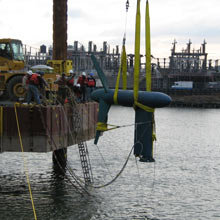Tides providing energy in NYC
 Working from barges and tugboats off New York City’s Roosevelt Island, engineers are battling northeasters and this month’s heavy spring tides to install the first major tidal-power project in the United States. The project involves a set of six submerged turbines that are designed to capture energy from the East River’s tidal currents. The three-bladed turbines, which are five meters in diameter and resemble wind turbines, are made by Verdant Power of Arlington, VA.
Working from barges and tugboats off New York City’s Roosevelt Island, engineers are battling northeasters and this month’s heavy spring tides to install the first major tidal-power project in the United States. The project involves a set of six submerged turbines that are designed to capture energy from the East River’s tidal currents. The three-bladed turbines, which are five meters in diameter and resemble wind turbines, are made by Verdant Power of Arlington, VA. Thanks to lessons learned by wind turbine designers, tidal power is already economically competitive, producing electricity at prices similar to wind power, according to feasibility studies by the Electric Power Research Institute, an industry R&D consortium. And it offers a big advantage over wind and other renewables: a precisely predictable source of energy. As a result, developers in the United States have laid claim to the best sites up and down the Atlantic and Pacific coasts. In the past four years the Federal Energy Regulatory Commission in Washington, DC, has issued preliminary permits for tidal installations at 25 sites, and it is considering another 31 applications.
Current-harvesting turbines represent a sharp break from the first wave of tidal power, so-called “barrages” in which impoundments installed across estuaries or bays created hydroelectric reservoirs refilled twice daily by rising tides. The La Rance barrage in Normandy has produced up to 240 megawatts of power - as much as many natural-gas-fired power plants - since 1966. Halifax utility Nova Scotia Power has been generating up to 20 megawatts of power since 1984 at a tidal barrage in the Bay of Fundy, whose funnel-shaped inlet produces the world’s largest tides - 16 meters at its head.
But these constructions have fallen out of favor because of their outsize impact on ocean ecosystems. James Taylor, general manager of environmental planning and monitoring for Nova Scotia Power, notes that commercial-scale installations planned for the Bay of Fundy in the 1980s would have altered tides as far away as Boston. “It would be a pretty hard thing to get permitted today,” says Taylor.
Hence the attraction of in-flow turbines such as Verdant’s. “The whole point of doing kinetic hydro is to have a very small environmental footprint,” says Dean Corren, Verdant’s director of technology development, who designed the tidal turbines in the early 1980s while conducting energy research at New York University.
Corren’s team installed its first two turbines in the East River in December. One has been delivering a maximum of 35 kilowatts of power to New York City, swivelling to generate power as the river swells with the high tides and empties with the low. The other turbine delivers performance data that Corren says will be crucial to refining the blades and gearbox, generator, and control system to optimize power generation.
This month Verdant added four more 35-kilowatt turbines. Corren says Verdant is now working on a next-generation design that will be cheaper to mass-produce, in anticipation of installing a farm of at least 100 turbines at the East River site.
Before the company proceeds, however, it must monitor the first six turbines for 18 months to assuage concerns of federal and state regulators that the turbines, whose tips cut through the water at up to nine meters per second, won’t chew up the river’s fish. Such qualms have already delayed the first-of-its-kind project by several years. Corren says monitoring to date has shown that few fish venture into the strong currents flowing past the turbines, but he says the extensive studies will provide a critical foundation for future developments.
Meanwhile, Canadian and European tidal-turbine producers are already scaling up their designs. Marine Current Turbines of Bristol, England, has operated an 11-meter, 300-kilowatt turbine off Devon for four years and plans to install a one-megawatt turbine in Northern Ireland’s Strangford Lough this year. Marine Current’s design resembles Verdant’s but uses two rotors, each with two blades. Other competitors are scaling up so-called ducted turbines, which are surrounded by a power-boosting shroud to guide water flow. Nova Scotia Power recently signed up Dublin’s OpenHydro to install a one-megawatt ducted turbine in the Bay of Fundy, while Vancouver-based Clean Current Power Systems is working on a two-megawatt version of the 65-kilowatt ducted turbine it installed off the coast of British Columbia in December.
Although scale will reduce costs, Clean Current president Glen Darou says the nascent industry will also have plenty of work ahead proving the reliability of its mechanical and electrical systems underwater. “Salt water is insidious,” says Darou; try as you might to seal it out, corrosive seawater “will get in there eventually.”
Source: MIT Press .
You can return to the main Market News page, or press the Back button on your browser.

